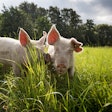For 2015, I have decided to focus on the following ingredients, which I believe merit the interest of the global feed industry as they represent innovative developments or represent solutions to difficult problems.
Functional proteins
This is an ongoing project, and it involves the use of immunoglobulins in piglet diets. It is not a brand new concept (I have been working on it since 2008), but with porcine epidemic diarrhea (PED) virus now appearing in Europe, there are already two countries here (Denmark and Ireland) that call for a voluntary withdrawal of plasma (major source of immunoglobulins), and, as such, alternative strategies are warranted for those who would like to heed this calling.
Functional fibers
I have been using them since day one, in one form or another (mostly as whole ingredients and rarely as purified forms), but this year I plan on taking a closer look on what I use currently in my piglet feeds and look for anything really new in the market that can do an even better job.
Algae
This I call the ingredient of the future, being either macro-algae or micro-algae. Seaweeds will dominate animal feeds in some years, probably when DDGS disappear, and I want to follow this new emerging technology from the beginning. My preliminary studies have only increased my appetite for more information.
Alternative forms of zinc oxide
New regulations at the EU level made me look for an alternative to normal zinc oxide (used at pharmacological dosages), and I believe I have a strong case for my choice of mix of ingredients that can do a similar or even better job. I have now to convince some of my clients that I took the right decision.
Molasses as a replacement of lactose
Quite an old story, but my consulting business has expanded in areas where lactose is scarce but molasses abounds. This being my favorite topic since my first days at Kansas State University, and after having designed many dairy-free nutrition programs for piglets, I am excited to go back working with this ingredient.
Soy products
I want to learn much more about fermented soybean meal. I believe there is a very good case going for this ingredient, but very little publicity. In addition, I have unearthed some data that further justified my reliance on soy protein concentrate for my piglet feeds, and I want to delve much deeper into the matter. And, what about low-antigen soy protein concentrate that is used in aqua feeds?
Feel free to add your own in the comments below.
Ioannis Mavromichalis can be reached at [email protected] and on LinkedIn.














